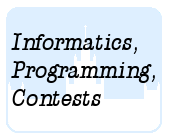Подразделы
Другие разделы
| 1471. As simple as it gets |
| 1472. Bit by bit |
| 1474. Deadlock detector |
| 1475. Быстрая помощь |
| 1476. Плотники |
| 1477. Шалтай-Болтай |
| 1478. Ферзи на шахматной доске |
| 1479. Хоттабыч и векторы на плоскости |
Дата и время
05/01/2026 08:07:30
 1473. Concatenation
1473. Concatenation
 Concatenation
Concatenation
 Дерево отрезков, декартово дерево, √-декомпозиция
Дерево отрезков, декартово дерево, √-декомпозицияОлимпиадные задачи на английском языке

| 24/06/2010 | Лето 2010 дорешивание (11C) |
| 16/07/2010 | Лето 2010 - 11 (C) |
Ограничения: время – 2s/4s, память – 64MiB Ввод: input.txt или стандартный ввод Вывод: output.txt или стандартный вывод 
Послать решение Blockly Посылки Темы Где Обсудить (0)
String concatenation is the operation of joining two character strings end to end. For example, the
strings "foo" and "bar" may be concatenated to give "foobar".
You program will be given `N` strings `a_1,\ …,\ a_N` and will have to perform `M` concatenations represented
by pairs of integers `(p_1,\ q_1),\ …,\ (p_M,\ q_M)`. Each pair `(p_j,\ q_j)` means that a new string `a_{N+j}` is the
concatenation of strings `a_{p_j}` and `a_{q_j}`, where `1\ ≤\ p_j,\ q_j\ <\ N\ +\ j`.
For example, strings "a" and "bc" and pairs `(1,\ 2),\ (3,\ 3)` mean that new strings "abc" and
"abcabc" are generated.
Your program must output a substring of `a_{N+M}` from position `L` to position `R`, counting from 1.
Input file format
First line of input file contains integers `N\ M\ L\ R`. Following `N` lines contain strings `a_i` – one string per line.
Each of the following `M` lines contain two integers `p_j\ q_j`.
Output file format
Output file must contain a string of `R\ -\ L\ +\ 1` characters.
Constraints
`1\ ≤\ N\ ≤\ 1000`, `1\ ≤\ M\ ≤\ 1000`,
`1\ ≤\ "length"(a_i)\ ≤\ 1000` for `i\ =\ 1,\ N`, `1\ ≤\ "length"(a_{N+j})\ ≤\ 2*10^9` for `j\ =\ 1,\ M`,
`1\ ≤\ L\ ≤\ R\ ≤\ "length"(a_{N+M})`, `R\ -\ L\ +\ 1\ ≤\ 1000`.
Sample Input 1
2 2 3 6 a bc 1 2 3 3
Sample Output 1
cabc
Sample Input 2
1 5 1 32 z 1 1 2 2 3 3 4 4 5 5
Sample Output 2
zzzzzzzzzzzzzzzzzzzzzzzzzzzzzzzz

 Начало
Начало